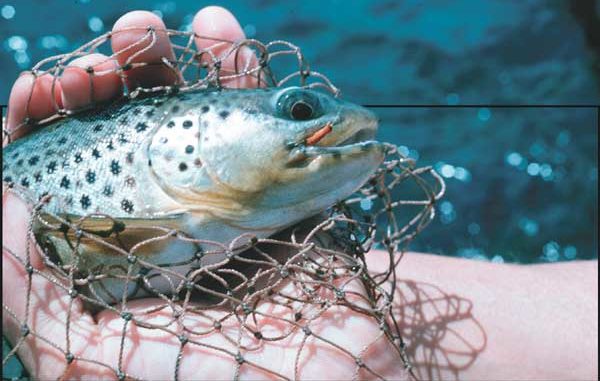
Fish the autumn spawn for South Carolina’s favorite fall trout.
The late Frank Young, a man with whom I talked and fished from boyhood days right up until his death, knew streams in the high country with an intimacy few will ever match. Decades ago, over the course of a 4-day autumn backpacking trip into trout country, he gave me an intensive course in dealing with brown trout — an enduring gift for which I will ever be grateful.
“For most of the year,” he said, “brown trout are about the biggest challenge you can face, but when the cooling temperatures and bluebird days of Indian Summer arrive, that changes.”
Frank went on to wax eloquent on the whole nature of brown trout behavior. “They are the back-alley bullies of the trout world,” he suggested, “creatures which like to hide in dark and secret places.”
By that he meant that the preferred habitat of browns is undercut banks, places where streams break their backs, deep pockets on the backside of rocks or logs, and most anywhere there is an eddy or backwater that allows them to hide in ambush without expending much energy. Moreover, for most of the year, brown trout show a distinct preference for times of low light, doing their feeding at dawn, dusk, during the night, or on dismal overcast days.
All these considerations combine to make browns a far more difficult quarry than brookies or rainbows — for most of the year. The exception, and it is a significant one, comes during the annual spawning migration. For browns, this comes during October, November, and perhaps on into early December.
Answering the most timeless of urges, the desire to procreate, mature browns (those old enough to lay or fertilize eggs), begin moving upstream into the headwaters where spawning takes place. This occurs with both trout resident in streams and also those living in cold-water lakes such as Jocassee.
During this period, brown trout are far easier to catch than at any other time. Marty Maxwell, the best hand with a fly rod on a trout stream I’ve encountered in the course of almost 60 years wading Carolina waters, explained why.
“To start with,” he said, “you can sight-fish for brown trout in this season. You will see them resting in large pools during their upstream migration or, later in the spawn, you can find them in small headwater creeks. That’s a sharp contrast to their behavior during the rest of the year, when they show a marked preference for dark holes and shaded locations, many of which are difficult, if not impossible, to fish.”
Another consideration Maxwell notes is the fact that browns feed right through the middle of the day during autumn.
“I guess they are stoking up against the coming hard times of winter,” he reckoned, “and of course, their movement upstream requires a lot of energy and necessitates heavy feeding.”
All of this translates to one undeniable consideration — from the glory days of Indian Summer right through to the cusp of winter, the quest for browns can be a mighty rewarding one.
South Carolina’s high-country streams offer ample opportunities to sample and savor the beauties of browns at a time of the year when leaf color, bracing temperatures, and generally fair weather beckon the sportsman in an irresistible fashion.
That calls for a more- detailed look at both destinations and tactics for taking brown trout in the fall, but before turning to that information, perhaps a bit of historical background is in order.
Brown trout are not native to South Carolina, at least not in the sense that they have always been here. Like rainbows, they are transplants, and when I was a youngster, it was common to hear old timers refer to rainbows as “California trout” and browns as “German trout.”
In each case, the moniker was a reference to the origin of the introduced fish, although in the case of browns, it should be noted that in addition to the German strain, there are also Loch Lomond browns (from Scotland). The only true native is the brook trout, and if you want to add confusion to the mix, brookies are not really trout. They are a close relative, members of the char family.
For most of us, however, what really matters is that browns, once they began to be stocked, found their new homes eminently suitable habitat. In the mountain vernacular, they “took holt.” That is to say, stocked browns showed ample ability to become “holdover fish,” with good numbers surviving the period when they are most vulnerable — in the weeks immediately after introduction.
These holdover fish soon began reproducing naturally, and today, numerous South Carolina creeks boast a solid population of stream-bred fish. They can’t truly be described as natives, but they are definitely wild fish. It is these wild fish, fully acclimated to their environment and thriving, that form the primary focus of fall fishing.
Where to go
My Grandpa Joe, a wonderful buddy and mentor who was really just a boy trapped in an old man’s body, was as full of tricks as a pet ’coon. He loved trout fishing with an abiding passion, and anytime you accompanied him on a stream, you could count on a running commentary offering his angling philosophy.
One of his favorite pronouncements — and he hammered it into my sometimes inattentive brain almost non-stop — involved prime fishing spots.
“Son,” he would say, “a man’s got to have some secrets.”
Little did he know that many years later, his understudy would face a constant dilemma when it came to such secrets. Finding prime fishing spots is an ongoing process of discovery, especially when such destinations lie in remote areas and are fairly fragile as far as the resource is concerned.
Accordingly, I’ve always been reluctant, in my writing, to do too much “hot spotting.” On the other hand, it’s only fair to give some specifics, and then along with them provide enough information to enable the inquisitive, hard-working angler to carry the delightful process of discovery to its logical conclusion: finding prime, relatively unpressured waters.
Given the fact that it is home to a fine population of browns, mention of Lake Jocassee is a must. It has been stocked with browns since the 1970s, and each year the S.C. Department of Natural Resources adds tens of thousands of stockers, which soon grow to legal harvest size for the reservoir. For present purposes however, it is fish leaving the lake to enter feeder streams that are of primary interest.
Venturing into the creeks and rivers that pour into Jocassee is not a matter to be approached casually. For starters, some of the major tributaries, most notably the Horsepasture and Toxaway Rivers, lie in North Carolina. Indeed, a small portion of the reservoir itself, the arm of Jocassee where the Horsepasture and Toxaway enter the lake, is in the Tarheel State. Since the two Carolinas do not have reciprocal licensing agreements, it is imperative that anglers know where they are (or possess licenses for both states).
Two other major feeders, at least in their lower reaches, do beckon those involved in fall’s brown trout quest. The first mile or so of the Thompson River lies in South Carolina, and its residents are almost exclusively browns. Its lower reaches feature deep plunge pools as it drops off the escarpment running along the state line.
In the early stages of the spawning run, it can provide great fishing, and this is a prime example of a stream that will never be overly pressured. The reason is simple: getting there is difficult, and once you are there, things get physically demanding indeed.
You can reach the Thompson by hiking along the Foothills Trail or by boat to the point where it enters Jocassee, and then work your way upstream. Either way, you are going to get a workout. The hike along the Foothills Trail covers several miles, and since it crosses the Thompson right at the North Carolina border, you need to work downstream.
If you take the boat route, there won’t be a long walk, but this approach does mean lots of scrambling around waterfalls and drops, then you’ve got to make your way back down to the lake. It’s rugged enough that anyone venturing to the Thompson should be accompanied by a fishing buddy.
The Whitewater River also offers South Carolina anglers about a mile of prime water for browns. There are approximately two miles of water between the upper and lower Whitewater Falls, with the bottom section of this stretch being situated in South Carolina. Access is at the Bad Creek Project off State Highway 130, where a spur off the Foothills Trail leads from the parking lot to the Whitewater. The walk is a short, easy one.
These streams hold plenty of browns, but their nature and limited South Carolina flow makes them pale in comparison to the Chattooga and some of its feeders.
For a glorious 10 miles, upstream from U.S. 28 all the way to Ellicott Rock, you have brown trout water aplenty. There are several access points from trails serving this National Wild and Scenic River, with the Burrells Ford Bridge being particularly noteworthy. Upstream from there, you will find almost exclusively wild browns. Fish are not stocked in the upper three miles, although there is stocking, via helicopter, downstream.
The higher up you go, the better, and the real way to enjoy the Chattooga at its best is by backpacking into more remote portions and spending two or three nights. Trails parallel it on the South Carolina side — it forms the state’s boundary with Georgia for miles, and the two states have a reciprocal licensing agreement, so anglers don’t have to worry about their whereabouts when fishing the stream. They can be accessed at the U.S. 28 bridge, the Burrells Ford Bridge, or by hiking in from several points including the Foothills Trail from Rt. 107 or from the fish hatchery at Walhalla along the Chattooga’s East Fork.
Speaking of the East Fork, once you get away from the immediate area of the hatchery, it is a gem. Browns aplenty are there throughout the year, but the stream really comes into its own in the fall when the big fish from the Chattooga move in.
The same is true for the East Fork’s tributaries, along with the South Carolina feeders of the main Chattooga. These include Indian Camp, Bad, and King Creeks, along with some others you’ll have to find on your own.
Speaking of “finding,” I am willing to give a couple of broad hints. First of all, get a good trail guide and make it as important an accessory as your vest or creel. From an overall perspective, the fifth edition of Alan de Hart’s Hiking South Carolina Trails is comprehensive and current, while those focusing on the Foothills Trail will find the section dealing with it in Johnny Molloy’s Long Trails of the Southeast or Guide to the Foothills Trail from the Foothills Trail Conference useful.
Second, when it comes to locating small streams, there’s no substitute for detailed topo maps. If a stream has a flow length of three miles or more, it likely carries enough water to appeal to spawning browns.
How to fish
Autumn angling usually means low waters, so considerable stealth, along with “far and fine” (long casts and light line), are required. For the fly fisherman, dry-fly attractor patterns such as Royal Wulff, Royal Trude, and Jim Charley are a good choice, as are ’hopper and caddis imitators.
For those with sufficient casting skills, combining these with a small beadhead nymph — Copper John, Prince, Gold-Ribbed Hare’s Ear, or Tellico — as a dropper means double trouble for browns. Or strip a weighted streamer such as a Matuka or Muddler Minnow.
For those whose preferences run to spin-casting or spinning tackle, small in-line spinners, any of the numerous small Rebel lures, or minnow and crayfish imitators are all good choices. If you happen to be astream when a rain has just turned the water a bit dingy (this rarely occurs in the typically good weather of Indian Summer), offerings of this type may be the best of all bets.
Whatever the water conditions though, there’s no time comparable to fall for dealing with sleek, golden fish adorned with brilliant spots of red.

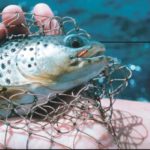

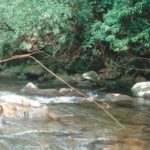
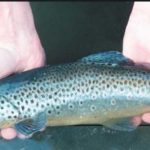

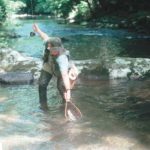
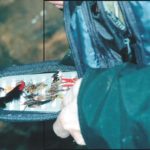
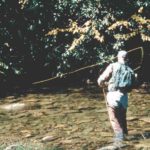


Be the first to comment